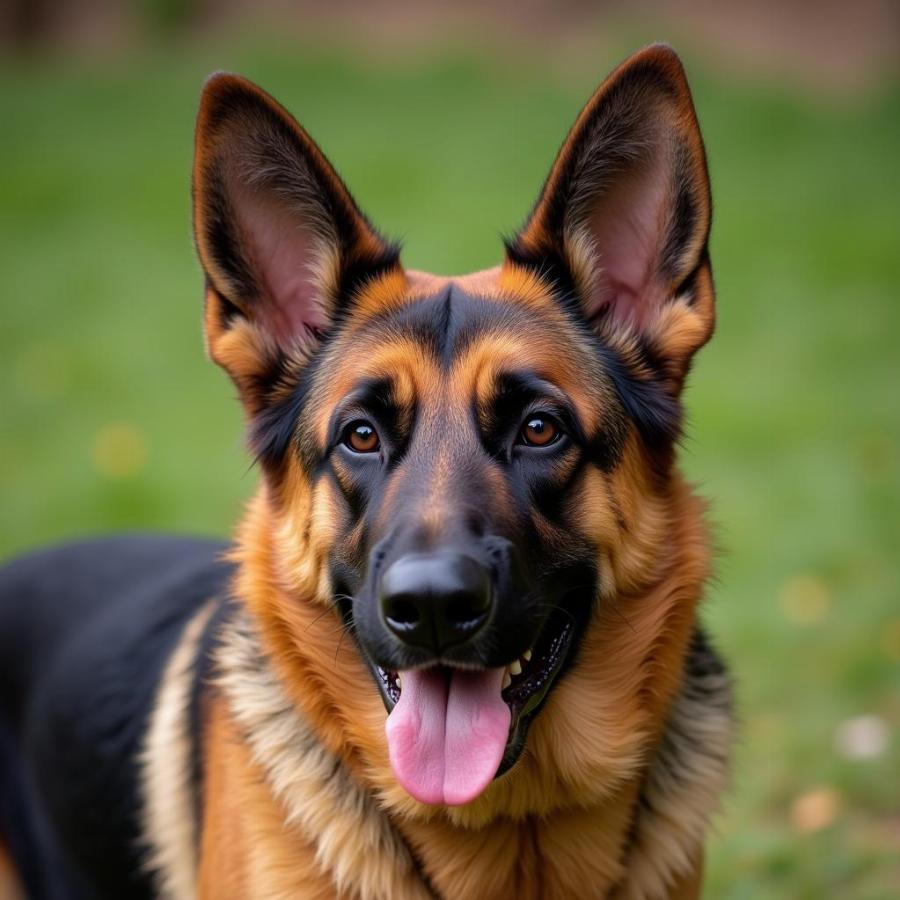Dogs with big ears are undeniably charming. Their expressive flaps add to their personality and often contribute to their unique and endearing appearance. But those impressive ears aren’t just for show! They actually serve a vital purpose, enhancing the dog’s hearing and even helping with communication. Whether you’re already smitten with a big-eared breed or simply curious about these captivating canines, this guide will delve into the fascinating world of dogs with big ears, exploring their breeds, care, and unique characteristics.
Why Are Some Dogs Blessed with Big Ears?
The size and shape of a dog’s ears are largely determined by breed. Selective breeding over centuries has resulted in the diverse ear types we see today, from the pricked ears of German Shepherds to the long, drooping ears of Basset Hounds. Big ears, particularly those that hang down, are often associated with scent hounds. The long, low-hanging ears help to sweep scents upwards towards the dog’s nose, improving their tracking abilities. Beyond functionality, big ears can also be a sign of a dog’s youth. Puppies often have proportionally larger ears than adult dogs, and their ears may not fully stand up until they are several months old.
Popular Dog Breeds with Big Ears
From small companions to large working dogs, numerous breeds boast prominent ears. Here’s a closer look at some popular choices:
-
Basset Hound: Known for their incredibly long ears, Basset Hounds are the quintessential big-eared breed. Their mournful expression and gentle nature make them beloved family pets. They have an exceptional sense of smell.
-
Bloodhound: Another scent hound with exceptionally long ears, Bloodhounds are renowned for their tracking abilities. Their powerful noses and determined personalities make them valuable assets in search and rescue operations.
-
Cocker Spaniel: These cheerful and affectionate dogs have long, feathered ears that add to their charming appearance. Cocker Spaniels are known for their playful nature and love of human companionship.
-
Beagle: These small but mighty hounds have medium-length, floppy ears that frame their inquisitive faces. Beagles are active and intelligent dogs who enjoy exploring and following their noses. indestructible balls for large dogs might be suitable for Beagles, despite their size.
Caring for Your Big-Eared Dog
Big ears require special attention to prevent infections. The warm, moist environment inside a floppy ear can be a breeding ground for bacteria and yeast. Regular cleaning with a vet-approved ear cleaner is essential. Be gentle and avoid inserting anything deep into the ear canal. Check your dog’s ears regularly for any signs of redness, swelling, or discharge.
What about Ear Infections?
Ear infections are a common problem in dogs with big ears. Symptoms can include head shaking, scratching at the ears, and a foul odor. If you suspect your dog has an ear infection, it’s crucial to seek veterinary care. dog bowl large are important for bigger dogs with bigger ears.
Big Ears and Communication
While primarily used for hearing and scent, a dog’s ears also play a role in communication. The position and movement of their ears can convey a range of emotions, from alertness and excitement to fear and submission. Observing your dog’s ear language can help you better understand their mood and intentions.
 German Shepherd Alert
German Shepherd Alert
Are Dogs With Big Ears More Prone to Hearing Problems?
Not necessarily. While large, floppy ears can trap moisture and debris, increasing the risk of infection, they don’t directly cause hearing problems. However, chronic ear infections can potentially lead to hearing loss if left untreated. Regular ear cleaning and prompt veterinary care are essential for maintaining your big-eared dog’s hearing health. You might also like to know more about big dogs pointy ears.
Conclusion
Dogs with big ears come in all shapes and sizes, each with its unique charm and personality. While those adorable ears add to their appeal, it’s essential to understand the specific care requirements that come with them. By providing proper ear care and attention, you can help ensure your big-eared companion enjoys a long, healthy, and happy life. Looking for a cute big dog breeds? Check out our guide.
FAQ
-
How often should I clean my dog’s ears? Generally, once a week is sufficient, but your vet may recommend more frequent cleaning if your dog is prone to ear infections.
-
What type of ear cleaner should I use? Always use a vet-approved ear cleaner specifically formulated for dogs.
-
Can I use cotton swabs to clean my dog’s ears? No, avoid using cotton swabs as they can push debris further into the ear canal and potentially damage the eardrum.
-
Are all dogs with big ears scent hounds? No, while many scent hounds have big ears, other breeds, like Cocker Spaniels, also have prominent ears.
-
Do big ears make dogs more susceptible to ear mites? Not necessarily, ear mites can affect any dog regardless of ear size.
-
What are the signs of an ear infection? Head shaking, scratching at the ears, redness, swelling, discharge, and a foul odor can all indicate an ear infection.
-
How can I prevent ear infections in my big-eared dog? Regular ear cleaning, keeping the ears dry, and addressing underlying allergies can help prevent ear infections.
Looking for More Information?
Check out these other helpful resources on our website:
- Dog Grooming Tips
- Choosing the Right Dog Breed
- Dog Health and Wellness
Beaut Dogs is your go-to resource for all things dog-related. We provide expert advice, helpful tips, and in-depth information to help you care for your canine companion. For personalized guidance and answers to your specific questions, please contact us at [email protected]. Beaut Dogs is committed to providing the best possible information for dog owners. Visit us at https://beautdogs.com.